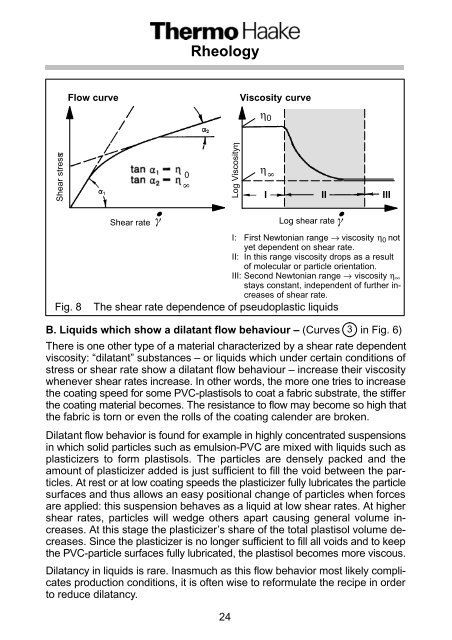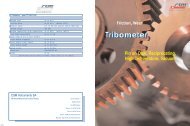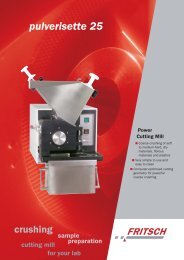- Page 2 and 3: Rheology A Practical Approach to Rh
- Page 4 and 5: Rheology Preface . . . . . . . . .
- Page 6 and 7: Rheology 6. Optimization of Rheomet
- Page 8 and 9: Rheology 10. Relative Polymer Rheom
- Page 10 and 11: Rheology sands of physicists, chemi
- Page 12 and 13: Rheology b) The famous glass window
- Page 14 and 15: Rheology Shear induced flow in liqu
- Page 16 and 17: 2.3 Shear rate Rheology The shear s
- Page 18 and 19: Rheology 2.6 Flow and viscosity cur
- Page 20 and 21: 2.7 Viscosity parameters Rheology V
- Page 22 and 23: Rheology A. Liquids which show pseu
- Page 26 and 27: Rheology When the network is disrup
- Page 28 and 29: Rheology The corresponding viscosit
- Page 30 and 31: Rheology Please note: Having listed
- Page 32 and 33: Rheology In rheometry really homoge
- Page 34 and 35: Viscosity [Pas] Rheology Shear rate
- Page 36 and 37: Rheology 3. Types of Rheometers/Vis
- Page 38 and 39: Rheology inside of the sensor syste
- Page 40 and 41: Rheology Searle System Couette Syst
- Page 42 and 43: Rheology One has to keep in mind th
- Page 44 and 45: Rheology b) CS- in comparison to CR
- Page 46 and 47: Shear stress [Pa] Rheology Shear ra
- Page 48 and 49: Viscosity [Pas] 467 6 Rheology Fig.
- Page 50 and 51: Rheology CR-data comparisons (see F
- Page 52 and 53: Rheology Testing a sample with a yi
- Page 54 and 55: 3.1.3 Equations Rheology Shear rate
- Page 56 and 57: Rheology B. Cone-and-plate sensor s
- Page 58 and 59: Rheology not larger than 3 mm since
- Page 60 and 61: Rheology This error can be minimize
- Page 62 and 63: Rheology b. “End effects” relat
- Page 64 and 65: Rheology as the air enclosed in the
- Page 66 and 67: Rheology Cone-and-plate sensor syst
- Page 68 and 69: 1 Cone with ceramic shaft 2 Lower p
- Page 70 and 71: 3.2 Capillary viscometers Rheology
- Page 72 and 73: Slit Die: left of center line P 1 P
- Page 74 and 75:
Rheology Polymer melts are typical
- Page 76 and 77:
Capillary Viscometry Means: Rheolog
- Page 78 and 79:
Rheology Good capillary viscometers
- Page 80 and 81:
Q Rheology Fig. 41 Schematic drawin
- Page 82 and 83:
Rheology effects which are “someh
- Page 84 and 85:
Rheology The viscosity η (mPa⋅s)
- Page 86 and 87:
Rheology 4. The Measurement of the
- Page 88 and 89:
Rheology temporary knots Fig.46 Int
- Page 90 and 91:
Rheology Fig. 47a. indicates the dr
- Page 92 and 93:
Rheology Using the above model imag
- Page 94 and 95:
Rheology The need to characterize t
- Page 96 and 97:
Rheology In the case of a liquid sh
- Page 98 and 99:
Shear stress [Pa] Rheology Normal f
- Page 100 and 101:
volume elements ∅ x length [mm] R
- Page 102 and 103:
Stress [Pa] Rheology Time [min] Fig
- Page 104 and 105:
Rheology In steady-state-flow bound
- Page 106 and 107:
Rheology ally increased. The slope
- Page 108 and 109:
Shear stress [Pa] Rheology t0 t1 Ti
- Page 110 and 111:
Please note: Rheology Strained samp
- Page 112 and 113:
c.4.) The Burger model - Fig. 62 Sh
- Page 114 and 115:
Rheology c.5.) Extended Maxwell and
- Page 116 and 117:
Rheology loss of deformation energy
- Page 118 and 119:
Height of specimen: hmax Rheology r
- Page 120 and 121:
Rheology approach for the measureme
- Page 122 and 123:
a.) The spring model - Fig.66 Strai
- Page 124 and 125:
Rheology c.) The Kelvin-Voigt model
- Page 126 and 127:
Rheology e.) Testing of real visco-
- Page 128 and 129:
Rheology These data must still be t
- Page 130 and 131:
storage modulus G’ [Pa] Rheology
- Page 132 and 133:
Rheology modulus G’ increases fir
- Page 134 and 135:
Rheology Samples subjected to produ
- Page 136 and 137:
moduli G’ + G’’ [Pa] moduli G
- Page 138 and 139:
moduli G’ +G’’ [Pa] Rheology
- Page 140 and 141:
complex viscosity η∗[Pas] Rheolo
- Page 142 and 143:
Rheology 5. The Relevance of Shear
- Page 144 and 145:
Rheology can hope to cover, apart f
- Page 146 and 147:
Rheology 5.2 Applying a latex layer
- Page 148 and 149:
Rheology 5.3 The problem of plug fl
- Page 150 and 151:
Rheology In normal processing, pain
- Page 152 and 153:
Shear rate is: � �w � � w
- Page 154 and 155:
5.4.2 Paper coating Rheology Qualit
- Page 156 and 157:
v Rheology Fig. 93 Cross section of
- Page 158 and 159:
Rheology Engine oils are not just s
- Page 160 and 161:
5.4.5 Lipstick application Rheology
- Page 162 and 163:
Rheology their disadvantage of bein
- Page 164 and 165:
Rheology Fig. 96 a Calibration set-
- Page 166 and 167:
Rheology As the result of the air-b
- Page 168 and 169:
Rheology markings in the table: too
- Page 170 and 171:
Fig. 98 Rheology viscosity [mPas] s
- Page 172 and 173:
Viscosity [mPas] Rheology Shear rat
- Page 174 and 175:
Rheology and shear rate ranges: CS-
- Page 176 and 177:
Rheology The tests which provided t
- Page 178 and 179:
Rheology When testing fluids posses
- Page 180 and 181:
shear stress [Pa] 50 40 30 20 10 Rh
- Page 182 and 183:
Rheology higher viscous samples. Th
- Page 184 and 185:
Rheology insufficient pre-warming p
- Page 186 and 187:
Rheology At low and medium shear ra
- Page 188 and 189:
Rheology The value η 1 can be assu
- Page 190 and 191:
Rheology 6.3.10 Disturbances caused
- Page 192 and 193:
Rheology will for some time provide
- Page 194 and 195:
Summary Rheology It is hoped that t
- Page 196 and 197:
Rheology This energy will cause a t
- Page 198 and 199:
shear stress [Pa] Rheology Fig. 116
- Page 200 and 201:
shear stress [Pa] Rheology 200 ÉÉ
- Page 202 and 203:
Rheology time, when the sample is s
- Page 204 and 205:
Rheology solid bonding of both oute
- Page 206 and 207:
shear stress [Pa] Rheology ketchup
- Page 208 and 209:
Rheology rate range, especially for
- Page 210 and 211:
Rheology These creep and recovery c
- Page 212 and 213:
Rheology test temperature is equal
- Page 214 and 215:
Rheology Torque M d-e acting on bot
- Page 216 and 217:
Rheology It is the great advantage
- Page 218 and 219:
Rheology for the evaluation of the
- Page 220 and 221:
Rheology by measured test points. A
- Page 222 and 223:
shear stress viscosity Carreau Regr
- Page 224 and 225:
Rheology 9.5 Corrections on measure
- Page 226 and 227:
Rheology injection molding. Slit ca
- Page 228 and 229:
Rheology the Bagley plot that the
- Page 230 and 231:
Rheology The “true” shear rate
- Page 232 and 233:
shear rate [1/s] �� t �� a
- Page 234 and 235:
Fig. 140 ”Apparent” and Weissen
- Page 236 and 237:
Rheology curves of a particular rhe
- Page 238 and 239:
Rheology The computer software for
- Page 240 and 241:
Rheology 9.7 Evaluation of the long
- Page 242 and 243:
Rheology ”a ” represents the vi
- Page 244 and 245:
Rheology 10. Relative Polymer Rheom
- Page 246 and 247:
Rheology rotor related to a typical
- Page 248 and 249:
Rheology 10.3 The relevance of rela
- Page 250 and 251:
Rheology melt temperature, of cours
- Page 252 and 253:
Rheology 10.6 Examples of processib
- Page 254 and 255:
Rheology related to their polymeriz
- Page 256 and 257:
Rheology mixers the polymers are su
- Page 258 and 259:
torque (viscosity) [Nm] torque (vis
- Page 260 and 261:
Rheology 10.6.7 Determining the tem
- Page 262 and 263:
Rheology The three polyethylene pol
- Page 264 and 265:
Rheology 11.2 Knowing the relevant
- Page 266 and 267:
Rheology 12. Literature References
- Page 268 and 269:
Rheology 13. Appendix: Information
- Page 270 and 271:
Rheology Type of instrument Design
- Page 272 and 273:
Rheology Type of instrument Design
- Page 274 and 275:
Rheology 13.2 Tabulated comparison
- Page 276 and 277:
13.2.2 Relative viscosity data Rheo
- Page 278 and 279:
Rheology 13.3 Comparison of the fal
- Page 280 and 281:
Rheology 13.4 An example of a stepw
- Page 282 and 283:
Rheology The example of a rheometer
- Page 284 and 285:
Rheology Fig. 169 is used to show t
- Page 286 and 287:
Shear stress [Pa] Rheology Shear ra
- Page 288 and 289:
shear stress [Pa] Rheology stress [
- Page 290 and 291:
Rheology Please note: to look more






